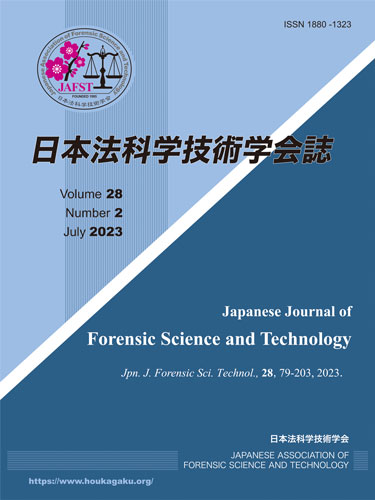Volume 28, Issue 2
Displaying 1-13 of 13 articles from this issue
- |<
- <
- 1
- >
- >|
Original Article
-
2023Volume 28Issue 2 Pages 79-90
Published: 2023
Released on J-STAGE: July 31, 2023
Advance online publication: April 07, 2023Download PDF (1545K) -
2023Volume 28Issue 2 Pages 91-102
Published: 2023
Released on J-STAGE: July 31, 2023
Advance online publication: April 14, 2023Download PDF (2123K) -
2023Volume 28Issue 2 Pages 103-112
Published: 2023
Released on J-STAGE: July 31, 2023
Advance online publication: May 19, 2023Download PDF (2893K) -
2023Volume 28Issue 2 Pages 113-122
Published: 2023
Released on J-STAGE: July 31, 2023
Advance online publication: June 06, 2023Download PDF (6399K)
Technical Note
-
2023Volume 28Issue 2 Pages 123-132
Published: 2023
Released on J-STAGE: July 31, 2023
Advance online publication: January 16, 2023Download PDF (826K) -
2022Volume 28Issue 2 Pages 133-144
Published: 2022
Released on J-STAGE: July 31, 2023
Advance online publication: December 29, 2022Download PDF (1069K) -
2023Volume 28Issue 2 Pages 145-157
Published: 2023
Released on J-STAGE: July 31, 2023
Advance online publication: April 20, 2023Download PDF (2236K) -
2023Volume 28Issue 2 Pages 159-167
Published: 2023
Released on J-STAGE: July 31, 2023
Advance online publication: April 07, 2023Download PDF (1648K) -
2023Volume 28Issue 2 Pages 169-176
Published: 2023
Released on J-STAGE: July 31, 2023
Advance online publication: May 11, 2023Download PDF (1332K) -
2023Volume 28Issue 2 Pages 177-182
Published: 2023
Released on J-STAGE: July 31, 2023
Advance online publication: May 26, 2023Download PDF (908K) -
2023Volume 28Issue 2 Pages 183-187
Published: 2023
Released on J-STAGE: July 31, 2023
Advance online publication: June 09, 2023Download PDF (936K)
Note
-
2023Volume 28Issue 2 Pages 189-196
Published: 2023
Released on J-STAGE: July 31, 2023
Advance online publication: February 28, 2023Download PDF (1532K) -
2023Volume 28Issue 2 Pages 197-203
Published: 2023
Released on J-STAGE: July 31, 2023
Advance online publication: April 20, 2023Download PDF (1322K)
- |<
- <
- 1
- >
- >|
